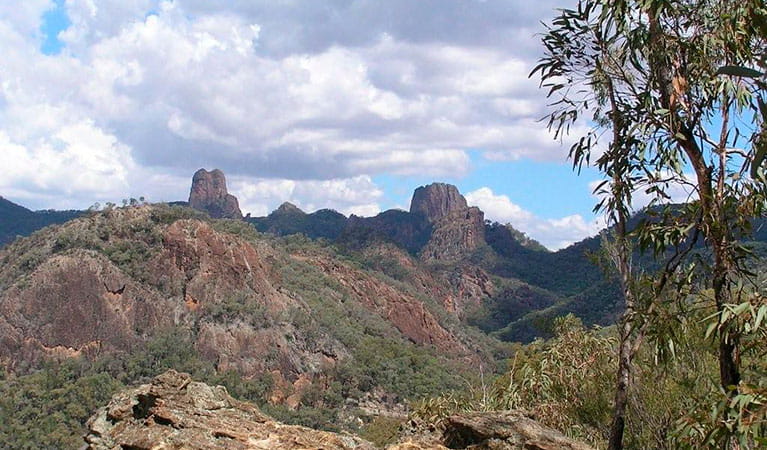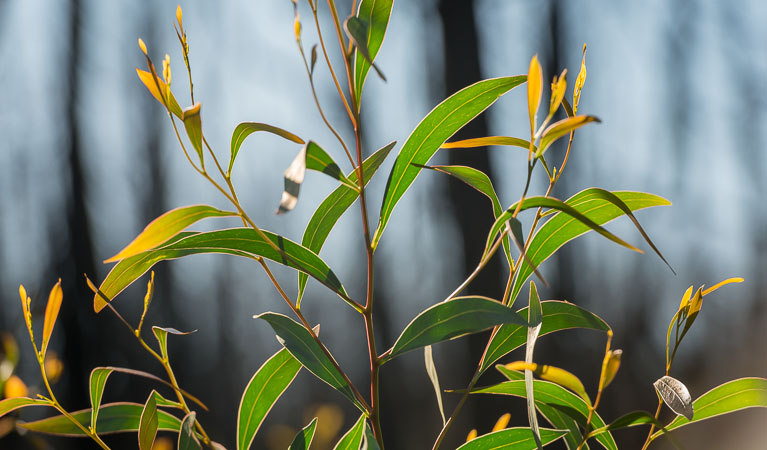Warrumbungle National Park after-fire program
The 2013 bushfires were the largest and most intense on record for Warrumbungle National Park. Almost 90 per cent of the park was burnt, but conservation programs and research have helped us better understand the impact of fire and how the park has recovered.
Read more about Warrumbungle National Park after-fire program
Nearly 40,000ha burnt on a single day of catastrophic weather conditions. An intense storm immediately following the fires then caused flash-flooding and massive soil erosion in some parts of the park.
These factors led to a major recovery program funded by the NSW Government, including a 3-year, $1.3 million research program by the Science, Economics and Insights Division. Additional funds went towards rebuilding park infrastructure, which followed the International Dark Sky Association guidelines making Warrumbungle National Park Australia’s first Dark Sky Park.
Rebuilding the visitor centre
The bushfire caused irreversible damage to buildings and facilities including the visitor centre. A completely new and redesigned building opened to visitors in 2018 and includes a visitor services area, retail space, gallery, information displays and visitor amenities. It’s built with sustainable materials, is fire resistant, uses solar power and collects rainwater.
The centre was shortlisted for the 2018 World Architecture Awards. It also won a Commendation for Public Buildings, and won the award for Sustainable Architecture in the 2020 NSW Australian Institute of Architects awards.
Tara Cave walking track
Tara Cave walking track was also badly damaged by the bushfires, as were most walking tracks. As part of the rebuild, more opportunities to learn about Aboriginal culture were added, including new infrastructure, signage and bush tucker plantings along the route.
NPWS worked with the Coonabarabran and Gulargambone Aboriginal communities on this program. This partnership informs park management and bushfire strategy while encouraging employment, training and experience for the local Aboriginal community.
Animal and plant recovery
Many animals were seen soon after the fire, including common species like grey kangaroos and red-rumped parrots, but also threatened species like squirrel gliders and brush-tailed rock-wallabies. In the years since, while some koalas have been seen, surveys have revealed low the numbers are part of a major regional decline as a result of the Millennium Drought, years of above-average temperatures and summer heatwaves.
Most of the 650 native plant species in the park were seen again within a few years post-fire, including a wide range of herbs, including native bluebells and daisies. Most of the 21 wattle species found in the park have also had mass flowering the years since. Also, 14 native plant species not previously known from the park were found, including 2 orchids that are stimulated by fire: the Lemon-scented Leek Orchid and Elephant’s Ears.
Whitegum lookout now has interpretive signs where visitors can learn about the 2013 bushfires, their impacts and how plants and animals have recovered.
Fire severity
Data collected in the research program was used in collaborations with the Centre for Environmental Risk Management of Bushfires at the University of Wollongong. Their research found that weather conditions were by far the biggest cause of the size and severity of the 2013 fires, as for more than 20 other major fires in NSW in the previous decade. They also found that more intense fire led to a higher number and diversity of wattles in the park. This is because many species have seeds in the soil that need intense heat to germinate them.
Geological discoveries
A detailed map of the geology of the park initiated as part of the program research filled a major gap in the geological map of NSW. It also showed that the central valley of the park is a volcanic crater. Studies of 10,000 year old deposits in the park by Macquarie University also found that intense fires have occurred in the Warrumbungle Ranges for almost 2,000 years.


